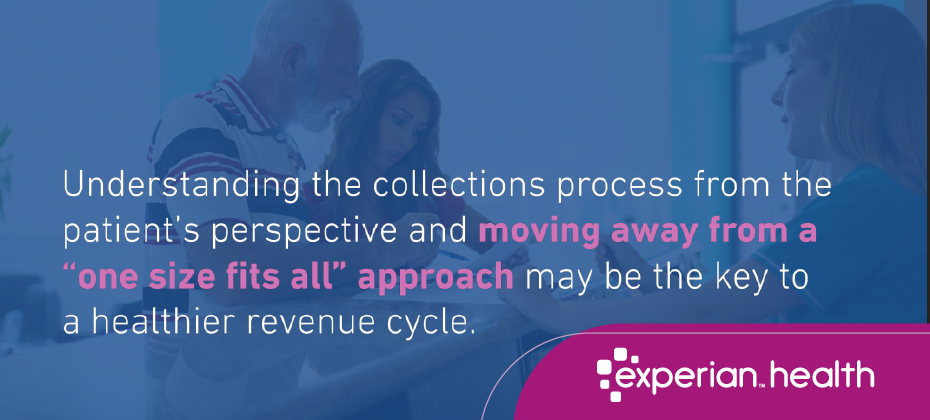
When it comes to paying for healthcare, “compassionate” is probably not the first word that comes to mind for patients. As they foot a greater portion of medical expenses, it’s often an experience rife with stress and uncertainty. Providers try to give accurate price estimates, but when patients switch coverage plans or payers change their policies, it’s difficult to be sure the original estimate matches the final bill.
And what if a patient simply can’t afford to pay? When 56% of consumers say they would not be able to pay an unexpected bill over $1000, this not only indicates a tough ride for patients, but points to why so many providers are struggling to collect in full – around two-thirds of patient balances over $200 go uncollected.
It’s unsurprising, then, that more healthcare organizations are looking at ways to create a better financial experience for patients. Understanding the collections process from the patient’s perspective and moving away from a “one size fits all” approach may be the key to a healthier revenue cycle. Could a more compassionate approach to billing help patients meet their financial obligations?
How providers are turning to compassionate billing to help patients and improve revenue
Thanks to advances in data analytics and technology, providers have a host of tools at their disposal to improve the patient financial experience. The following three strategies are generating some great results for providers:
1. Use data to give patients the right payment options
A common pitfall across healthcare billing is to treat every patient the same. But sending a bill and hoping it gets paid is clearly not a reliable collections strategy. A compassionate billing approach means you look at each patient’s current financial situation and consider their ability and likelihood to pay.
With the rich data analytics now available, you’ll know whether a simple statement will be enough to prompt payment from the patient, or whether a little extra handholding will be needed. Are there other payment plans that might be more appropriate? Would they benefit from a call or text to remind them of the next task they need to complete? Data analytics let you tailor the process so you can help your patients pay their bills in the way that suits them best, including finding missing coverage.
Novant Health used Collections Optimization Manager to automate and increase patient collections. With this solution, Novant Health saw a 5.8% increase in unit yield year-over-year, and an overall recovery rate of 6.5%. Overall increased revenue and cost savings amount to an impressive rolling average return on investment – 8.5:1.
2. Personalize the way you communicate with patients
Data analytics don’t just help you offer payment plans based on the individual, they allow you to determine a patient’s preferred method of communication. Do they prefer to get a statement in the mail or via email? Are there particular communication messages that will resonate with different patient groups? Paying bills can be a sensitive topic, especially if someone is struggling financially. Being able to create personalized messages at each touch point in the process is a helpful way to build compassion and consumer trust into the financial experience, so patients are more likely to engage with the process.
The University of California San Diego transformed their patient financial experience by using Collections Optimization Manager to segment patients, as part of a broader exercise to improve collections. Knowing more about individual patients’ circumstances meant they could offer more relevant communications and build a more sensitive patient engagement strategy.
3. Make it convenient and easy to pay
Every patient will thank you for a quick and painless payment process. Offering flexible payment options including online, in person and phone is critical.
According to Kyle Wilcox of Grinnell Regional Medical Center, this is all about the ‘golden rule’ of patient payments: treating patients as you would want to be treated. He says:
“At GRMC, we provide consumers with a range of choices to make payments, such as in person, by mail, electronically online or via mobile technology, and by cash, credit or debit card. Doing so allows them to pay in a way that is most convenient for them, improving their satisfaction and the hospital’s likelihood of receiving payment.”
What’s more, efficient payment tools can improve your staff workflows too, giving them more time to help patients who need extra assistance and reducing the cost to collect. Heather Grover, Vice President of Product Management for Patient Collections, Experian Health, said:
“We had a small community-based hospital use Collections Optimization Manager product with PatientDial. On average, the cost to collect for many of our clients is anywhere between 7% and 15%. They saw theirs decline to 5% and over a two-year period, their cash collections increased to 42% prior.”
Ultimately, there are some patients who can pay and some who can’t. It’s a sensitive topic to navigate, but when patients feel supported, they’re more likely to be able to meet their financial obligations. Collections Optimization Manager lets you figure out who’s who and offer them the most appropriate support to get their healthcare bills paid, so they can get on with life.


